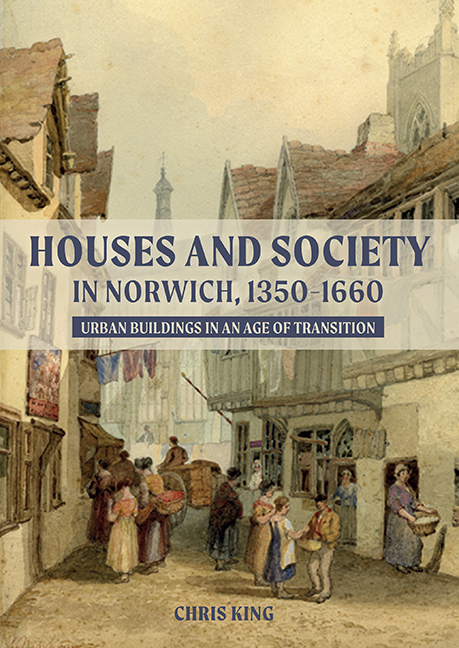Book contents
- Frontmatter
- Dedication
- Contents
- List of plates and figures
- List of tables
- Acknowledgements
- List of Abbreviations
- 1 Urban rebuildings, urban transitions
- 2 Norwich, 1350–1660: continuity and change in an English provincial city
- 3 Medieval merchants’ houses, c.1350–1540
- 4 Early modern merchants’ houses, c.1540–1660
- 5 The urban elite: domestic space, social identity and civic authority
- 6 Medieval houses and the urban ‘great rebuilding’
- 7 Houses of the ‘middling sort’: buildings and the use of space
- 8 Housing the urban poor and immigrant communities
- Conclusions
- Glossary
- Bibliography
- Index
- Plate Section
Conclusions
Published online by Cambridge University Press: 23 October 2020
- Frontmatter
- Dedication
- Contents
- List of plates and figures
- List of tables
- Acknowledgements
- List of Abbreviations
- 1 Urban rebuildings, urban transitions
- 2 Norwich, 1350–1660: continuity and change in an English provincial city
- 3 Medieval merchants’ houses, c.1350–1540
- 4 Early modern merchants’ houses, c.1540–1660
- 5 The urban elite: domestic space, social identity and civic authority
- 6 Medieval houses and the urban ‘great rebuilding’
- 7 Houses of the ‘middling sort’: buildings and the use of space
- 8 Housing the urban poor and immigrant communities
- Conclusions
- Glossary
- Bibliography
- Index
- Plate Section
Summary
I began this work with two broad aims in mind. One of these was to introduce to a wider audience the archaeological evidence for late medieval and early modern domestic buildings in Norwich, England's ‘second city’. This, at least, I hope has been achieved. The building recording undertaken by the Norwich Survey in the 1970s provides an invaluable starting point for assessing broad trends in the development of domestic architecture in the city, and the failure to publish the majority of this material in a coherent or comprehensive manner has until now hampered scholars in their efforts to produce a detailed and comprehensive view of buildings and the urban landscape in what was once England's ‘second city’. This work has demonstrated the large numbers of buildings that survive in the city, most particularly those associated with the mercantile elite, but stretching across the social scale, and their potential as a source of information about medieval and early modern urban society.
The value of an integrated approach to standing building and excavated evidence has also been established, providing a fuller account of both the range of building forms and a more fine-grained chronology of the development of buildings in the city. While no single survey can hope to be comprehensive, my aim was to highlight the benefits of an interdisciplinary methodological approach in which documentary sources and material evidence can be useful to both complement and interrogate one another. While it is unlikely that many wholly new historic buildings will be discovered within the central area, archaeological excavations will continue to reveal new domestic sites and architectural fragments will continue to emerge, and each piece of evidence can influence the broader picture. It is my hope that the present work will contribute to a greater understanding of the development of the city’s dynamic and ever-changing urban landscape. The rich architectural inheritance of the city's everyday buildings is both an essential historical resource and a major contributing factor to the unique townscape and sense of place that makes Norwich such a fine city to live and work in.
- Type
- Chapter
- Information
- Houses and Society in Norwich, 1350–1660Urban Buildings in an Age of Transition, pp. 279 - 284Publisher: Boydell & BrewerPrint publication year: 2020



